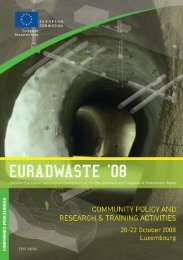EU industrial structure - EU Bookshop - Europa
EU industrial structure - EU Bookshop - Europa
EU industrial structure - EU Bookshop - Europa
You also want an ePaper? Increase the reach of your titles
YUMPU automatically turns print PDFs into web optimized ePapers that Google loves.
<strong>EU</strong> <strong>industrial</strong> <strong>structure</strong> 2011 — Trends and Performance<br />
TAbLE IV.10: Manufactured products - World trade matrix, income level: exports in 2009 (%)<br />
Export Eu‑27<br />
120<br />
high<br />
income<br />
non Eu‑27<br />
upper<br />
medium<br />
income<br />
destination<br />
low<br />
medium<br />
income<br />
low<br />
income<br />
Origin <strong>EU</strong>‑27 26.9 7.3 3.3 2.9 0.4 40.6<br />
High income non <strong>EU</strong>‑27 6.3 12.8 3.9 7.5 0.6 31.1<br />
Upper medium income 3.4 4.3 1.5 2.1 0.3 11.5<br />
Low medium income 3.3 8.2 1.7 1.9 0.9 16.0<br />
Low income 0.1 0.4 0.1 0.2 0.1 1.0<br />
world<br />
World 39.8 33.1 10.4 14.6 2.2 100.0<br />
Note: Due to rounding, certain columns or rows do not add up to 100 %. The matrix is calculated from export data. It refers exclusively<br />
to manufactured products, so it does not include crude oil and other products from mining and quarrying. The values in each cell are<br />
percentage shares of total world trade. The main diagonal in the matrix (shaded cells) represents intra‑region trade (e.g. exports from <strong>EU</strong><br />
countries to <strong>EU</strong> countries). Each cell shows the share of total world exports which are exported from an exporter to a certain destination.<br />
For example, Upper medium income countries’ exports to <strong>EU</strong>‑27 accounts for 3.4 % of total world exports and total Upper median income<br />
countries’ exports accounts for 11.5 % of total world exports.<br />
Source: own calculations using COMTRADE data.<br />
When intra‑regional <strong>EU</strong> trade is excluded from the data,<br />
the largest share of <strong>EU</strong>‑27 trade (both exports and imports)<br />
takes place with high income countries. Some 53 % of<br />
extra‑<strong>EU</strong> exports go to other high‑income countries,<br />
and 56 % of imports originate from high‑income countries<br />
towards the <strong>EU</strong>. However, 21 % of extra‑<strong>EU</strong> exports go to<br />
low‑medium income countries, and 18% of <strong>EU</strong> imports also<br />
originate from these countries, cf. Tables IV.11 and IV.12.<br />
TAbLE IV.11: Manufactured products - World trade matrix income level: destination of exports in 2009 (%)<br />
Export Eu‑27<br />
high<br />
income non<br />
Eu‑27<br />
upper<br />
medium<br />
income<br />
destination<br />
low<br />
medium<br />
income<br />
low income world<br />
Origin <strong>EU</strong>‑27 0.0 52.8 23.9 20.8 2.6 100.0<br />
High income non <strong>EU</strong>‑27 34.5 0.0 21.1 41.0 3.4 100.0<br />
Upper medium income 33.7 43.0 0.0 20.6 3.1 100.0<br />
Low medium income 23.2 58.5 12.3 0.0 6.1 100.0<br />
Low income 15.8 47.3 8.9 28.0 0.0 100.0<br />
Note: Due to rounding, certain columns or rows do not add up to 100 %. The matrix is calculated from export data. It refers exclusively to<br />
manufactured products, so it does not include crude oil and other products from mining and quarrying. The main diagonal in the matrix<br />
(shaded cells) shows that intra‑regional trade (e.g. exports from <strong>EU</strong> countries to <strong>EU</strong> countries) is excluded in this table. Exporters are<br />
shown in rows and destination markets in columns. Each cell shows the share of total exports from an exporter to a certain destination.<br />
For example, 33.7 % of Upper medium income countries’ exports are destined for <strong>EU</strong>‑27.<br />
Source: own calculations using COMTRADE data.
















